Tranexamic Acid Pill for Melasma
Melasma Treatment with Oral Tranexamic Acid
Melasma is a skin condition that causes hyperpigmented patches or spots on the skin. For many of us who suffer from melasma, the discoloration can make us self-conscious as we look for ways to treat or cover the hyperpigmentation. Melasma may fade over time, but all too often it is a chronic condition . Thankfully, there are cosmetic treatments available to diminish the pigmentation or completely remove the hyperpigmentation. Popular topical treatments for melasma include topical hydroquinone for skin lightening, retinols, Kojic acid, Vitamin C, and Niacinamide. Dr. Michele Green in is at the forefront of cosmetic treatments to reduce melasma in her private NYD dermatology office. She incorporates the latest cosmetic treatments, including chemical peels, microneedling, lasers, and Cosmelan peels to reduce pigmentation and leave you with healthy, clear skin. In addition to these well known treatments, Dr. Green is incorporating oral Tranexamic acid as an adjunct treatment to reduce the hyperpigmentation of facial melasma.
Oral tranexamic acid was originally FDA approved to treat bleeding disorders. Recently, it has been studied for the treatment of refractory melasma, hyperpigmentation, and post-inflammatory hyperpigmentation. This off-label indication for treating melasma has been gaining in popularity. There are currently two forms – a topical tranexamic acid and an oral tranexamic acid in pill form. Fewer studies have reviewed long term us to the topical tranexamic acid for melasma. However, recent studies of oral tranexamic acid in treating hyperpigmentation and melasma have been quite promising. Clinical trials have confirmed the efficacy of oral tranexamic acid for melasma, and even better cosmetic results when combined with other topical therapies and treatments.
Dr. Michele Green is a board-certified cosmetic dermatologist and specialist in melasma and hyperpigmentation. She has been treating melasma patients of all skin types for over 25 years in her boutique private Upper East Side, NYC dermatology office. Dr. Green is consistently voted as one of the best dermatologists in NYC by Castle Connolly, The New York Times, Super Doctors, and New York Magazine. Dr. Green specializes in the treatment of facial melasma and disorders of pigmentation. If you are suffering from dark spots, hyperpigmentation, or melasma, Dr. Green is here to help to discuss safe and effective treatment options for your skin.
What is melasma?
Melasma, also known as chloasma, is a complex skin condition characterized by brown or grayish hyperpigmentation of the face that presents as patches or freckle-like spots. Melasma occurs because the melanocytes, the cells responsible for skin pigmentation, is hyperactive and produces excess melanin. Melanin is the pigment that gives the skin its color. Although more research is needed to understand the exact cause of the hyperactivity of melanocytes in melasma, it may be triggered and exacerbated by other factors that causes the melanocytes to go into overdrive. Possible triggers include ultraviolet (UV) light exposure, pregnancy, sex hormones, stress, thyroid disease, and some medications like birth control (contraceptive) pills and anti-seizure (phototoxic) medications. Melasma is treatable, not curable. There are no treatments available at this time to permanently get rid of melasma, but there are numerous treatments that help lighten hyperpigmentation and prevent melasma from returning or worsening.
Melasma is a very common skin condition, occurring more commonly in women than men. According to the American Academy of Dermatology, 90% of melasma occurs in women, and it’s most common among women between the ages of 20 and 40. Melasma is often referred to as “the mask of pregnancy” because it affects between 15-50% of pregnant women. Those with darker skin are more susceptible to developing melasma, especially in patients with type IV or darker skin tone. Melasma treatment is a popular topic in healthcare; although melasma is benign, it can cause severe psychological and social issues in melasma patients.
What is oral tranexamic acid?
Tranexamic acid, also known for its brand name Lysteda, is a synthetic derivative of lysine that is prescribed as an antifibrinolytic agent to treat bleeding disorders. Currently, it is approved by the FDA to treat heavy menstrual bleeding and short-term prevention in those with hemophilia. Tranexamic acid works to prevent excessive bleeding by hindering the breakdown of fibrin, which is the main protein in blood clots.
Clinical studies have also shown tranexamic acid’s efficacy in the treatment of melasma. As an off-label prescription, oral tranexamic acid at a low dosage has been used to slow melanin synthesis to treat melasma. Oral tranexamic acid has shown to have differing effects on the body depending on the dosage. Higher dosage seem to have a noticeable blood clotting effect, while lower dosage seem to hinder melanogenesis without the blood clotting properties. Dermatologists prescribe a low dose oral tranexamic acid for melasma treatment because it poses a very low risk for deep vein thrombosis, thromboembolism, and possible stroke, while still being effective in treating melasma.
What are the side effects of oral tranexamic acid?
Tranexamic acid may cause minor side effects which usually resolve on their own and do not require medical attention. These side effects disappear as the body acclimates to the medicine.
Common side effects include:
- Nausea and/or vomiting
- Stomach pain or discomfort
- Diarrhea
- Chills
- Fever
- Headache
- Muscle pain or muscle stiffness
- Runny or stuffy nose
Some rare but serious side effects include anaphylaxis, changes in vision, confusion, anxiety, pale skin, unusual bleeding, unusual bruising, unusual fatigue, and numbness in the hands. These adverse events should be reported to and treated by medical personnel immediately, and a follow-up with the dermatologist is highly advised. Refer to FDA.gov for additional information.
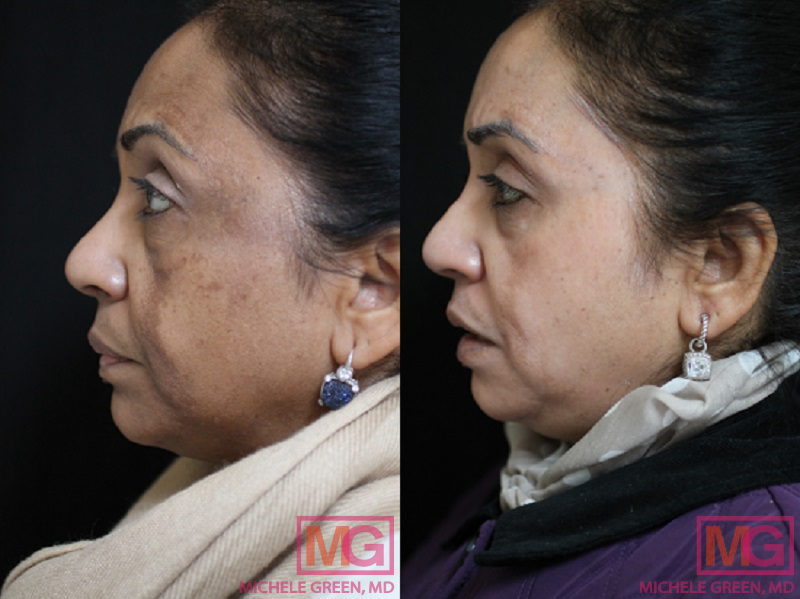
Treated with Chemical Peels, before and after
How does Tranexamic acid for melasma work?
Researchers have discovered that tranexamic acid inhibits the plasminogen/plasmin pathway, which inhibits the interactions between melanocytes and keratinocytes. Melanocytes are skin cells that produce melanin, and melanin is the pigment that gives our skin its color. Keratinocytes are cells in the skin responsible for producing keratin, and they also receive melanin produced by melanocytes. The pigment in the skin that is visible is due to the melanin within keratinocytes. Tranexamic acid has also found to inhibit tyrosinase activity to reduce hyperpigmentation. Tyrosinase is an enzyme that catalyzes the first step of melanin synthesis from the protein tyrosine. This mechanism of action of tranexamic acid leads to a slowed melanin synthesis and lightened hyperpigmentation.
Does tranexamic acid work for melasma?
Tranexamic acid is a sought out treatment for melasma because of its efficacy and mild side effects. The effectiveness of tranexamic acid has been documented in various journals like Dermatol, J Am Acad dermatol, Dermatol Ther, and Clin Exp dermatol. In an 8 week placebo-controlled study, the combination of oral tranexamic acid and topical tranexamic acid showed a significant improvement in epidermal pigmentation. Another study found 80.9% improvement rate with 6-15 month use of oral tranexamic acid with very mild side effects reported.
What other melasma treatments can be incorporated with oral tranexamic acid?
Oral tranexamic acid for melasma is beneficial because it can be taken in combination with cosmetic treatments and topical formulations. Some dermatologists may recommend a combination of oral tranexamic acid and laser treatments like IPL or Nd:YAG laser. However, lasers should be used with caution in melasma treatment, especially in darker skin tones, because it can often worsen melasma and hyperpigmentation. Additionally, melasma can become even more difficult to treat following laser treatments because the pigment is embedded deeper into the skin.
Furthermore, patients may also use oral tranexamic acid in combination with topical treatments. Vitamin C has been a popular skincare ingredient due to its antioxidant properties and ability to stabilize free radicals caused by ultraviolet radiation that cause damage to the skin. Vitamin C has been used to treat and prevent hyperpigmentation for decades and can easily be found in various skincare products on the market. Dr. Green has her own, specially formulated Vitamin C Serum with high concentration of vitamin C to prevent sun damage, diminish brown or red spots, and nourish the skin. Some dermatologists may also recommend a triple combination cream containing hydroquinone 4%, tretinoin 0.05%, and flucinolone acetonide 0.01% in combination with oral tranexamic acid to treat melasma and lighten hyperpigmentation.
Applying sunscreen is still a key step in the daily skincare routine while taking oral tranexamic acid. One clinical study found 0.4% (2 patients) of the studied melasma patients whose hyperpigmentation worsened while taking oral tranexamic acid. Further investigation by researchers showed that sun exposure contributed to worsening of melasma in those patients. Although tranexamic acid does not make your skin photosensitive like hydroquinone, the sun’s ultraviolet radiation can worsen hyperpigmentation on unprotected skin. Therefore, sunscreen should not be forgotten or eliminated from daily skincare routine to ensure the melasma does not worsen or return. Protecting your skin from the sun’s harmful ultraviolet rays using sunscreen and protective clothing is also beneficial for avoiding premature aging as well as skin cancer. Don’t forget to reapply sunscreen every 90 minutes and apply on all areas of the body that is exposed to the sun.
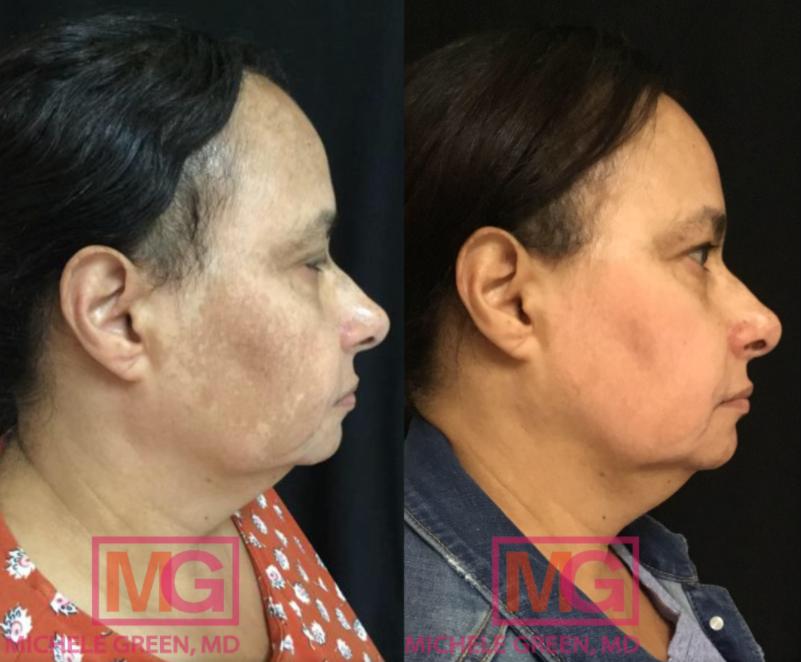
Cosmelan treatment for Melasma before and after
How to use tranexamic acid for melasma
Tranexamic acid for melasma can be taken orally at a low dosage or applied topically on the skin. Oral tranexamic acid for melasma treatment is an off-label use and must be prescribed by a board-certified dermatologist. The dermatologist will assess medical history, risk factors, and treatment goals to determine if oral tranexamic acid is recommended for you. The frequency and longevity of oral tranexamic acid use depends on your dermatologist’s recommendation based on clinical studies and risk factors. One recent study, in the Eur J Dermatol 2019;29(1):55-58. doi:.10.1684/ejd.2018.3494 thoroughly reviews the different dosages of oral tranexamic acid on melasma.
Topical tranexamic acid has also shown efficacy in treating melasma without the systemic side effects or oral tranexamic acid. There are many skincare products available on the market that contains tranexamic acid as an active ingredient. The product can be used in between cleanser and moisturizer, followed by SPF 50 sunscreen. With any new skincare product or ingredient, introduce it slowly into the skincare routine to look out for adverse reactions. If you have known sensitive skin, perform a patch test on a small, discreet area and wait a few days to ensure there is no delayed reaction.
How long can I take tranexamic acid for melasma?
Tranexamic acid is generally safe to use for a long period of time without any harmful side effects. The maximum effects of tranexamic acid can be seen after eight to twelve weeks of consistent treatment. Because it works by pausing melanin synthesis, studies found that the melasma can return after stopping the medication. Therefore, dermatologists may recommend individualized treatment plan consisting of a period of taking oral tranexamic acid and a period of pausing the prescription to give your body a break. Clinical studies showed that it takes about three months after stopping tranexamic acid to see signs of melasma returning. There are many short-term clinical trials on the effect of oral tranexamic acid, but there is not enough data on long-term effects yet. However, dermatologists have been prescribing oral tranexamic acid for melasma for decades.
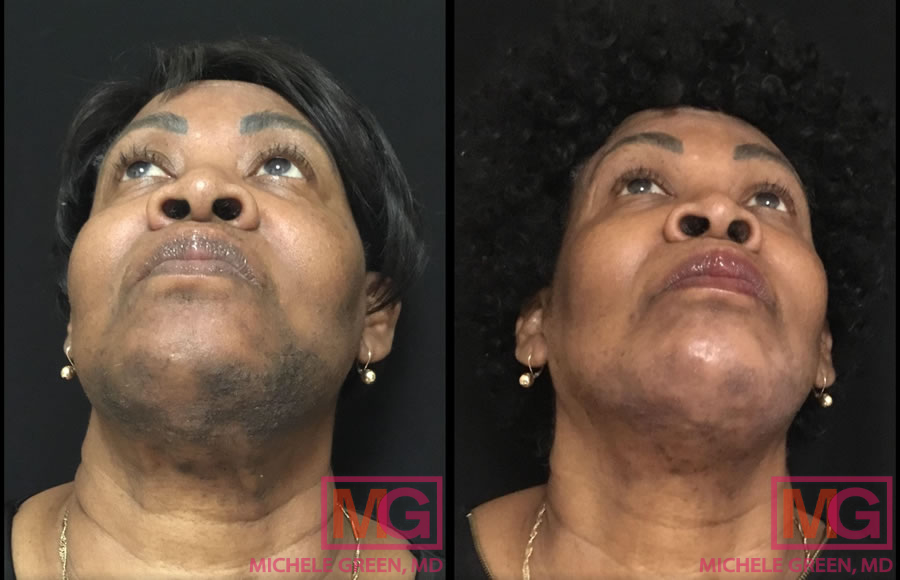
Chemical peel – 2 months before and after
Is Tranexamic acid good for melasma?
Various clinical studies have shown that tranexamic acid is effective in treating refractory melasma with little to no side effects. Researchers studied 561 melasma patients who took oral tranexamic acid for four months, and almost 90% of the patients reported significant decrease in melasma area and severity index within two months. Another study compared 60 female melasma patients using topical tranexamic acid and topical hydroquinone. Both randomized groups reported significant improvement, although the hydroquinone group reported more side effects and lower patient satisfaction compared to the tranexamic acid group.
Is Tranexamic acid good for skin?
Oral and topical tranexamic acid provide many benefits to the skin, including decreased sensitivity to the sun and diminished hyperpigmentation. Unlike the popular lightening agent hydroquinone, which makes your skin more sensitive to the sun, tranexamic acid has the opposite effect and protects the skin from ultraviolet rays. Furthermore, tranexamic acid may have other therapeutic effects aside from preventing ultraviolet radiation-induced melanogenesis and lightening hyperpigmentation associated with melasma.
Topical Tranexamic acid has also been shown to be effective in treating patients with rosacea. Tranexamic acid has been found to decrease redness and reduce number of blood vessels. Researchers found that topical tranexamic acid helps reduce rosacea symptoms by strengthening the skin barrier. The skin barrier acts as a protection against environmental toxins and irritants while reserving moisture in the skin to keep it hydrated. A 2015 study found that rosacea patients who applied 3% tranexamic acid to the skin for 2 weeks showed decreased visible signs of rosacea than those who did not use tranexamic acid.
Is Tranexamic acid safe for skin?
Various clinical studies have proven oral and topical tranexamic acid to be safe for the skin. Topical hydroquinone, a gold standard for lightening pigmentation for decades, has a history of reported adverse events such as irritant dermatitis, allergic contact dermatitis and post-inflammatory hyperpigmentation. Although oral tranexamic acid has reported mild, temporary side effects as the body becomes accustomed to the new medication, topical tranexamic acid has even less reported side effects. Common side effects for topical tranexamic acid include dryness, irritation, and flaking.
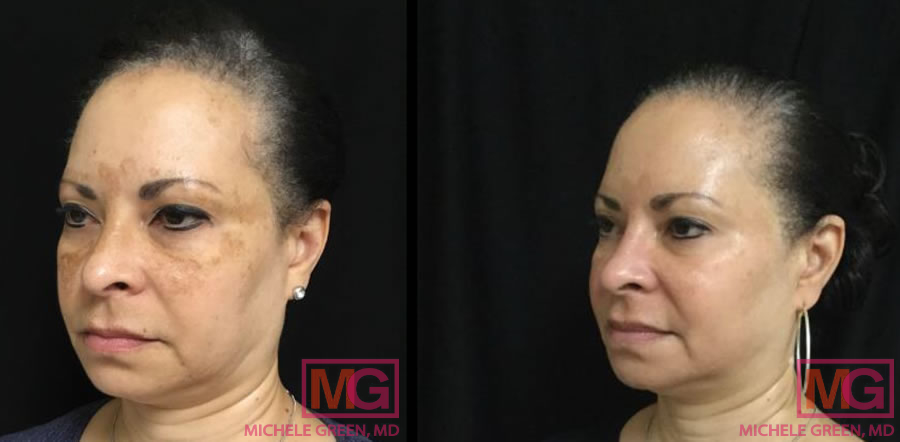
Before and after: Cosmelan treatment – 6 months
Is tranexamic acid safe for dark skin?
Both oral tranexamic acid and topical tranexamic acid are safe to use for all skin types and tones, including dark skin. Oral tranexamic acid has shown similar efficacy across all different skin types. This is a major benefit in melasma treatment as the tranexamic acid treatment does not have to be individualized and catered to the skin type.
Oral tranexamic acid has also been found in recent research to be effective in the treatment of other hyperpigmentation disorders such as postinflammatory hyperpigmentation treatment and prevention, lichen planus pigmentosus, ashy dermatosis, and Riehl melanosis.
Is topical tranexamic acid safe to use on the face?
Yes! Topical tranexamic acid is safe to use on the face. There are various skincare products available with tranexamic acid as an active ingredient. Any new skincare ingredient should be introduced slowly, starting with once a week use and gradually increasing to daily use over time. Be observant to any adverse reactions and discontinue to the product immediately if any signs of irritation occurs. Dr. Green prefers Mesoesthetic’s Melan Tran3x gel cream and concentrate to lighten hyperpigmentation without the irritating factors of hydroquinone. As always, consult with a board-certified dermatologist like Dr. Michele Green to determine if tranexamic acid is a recommended skincare ingredient for you.
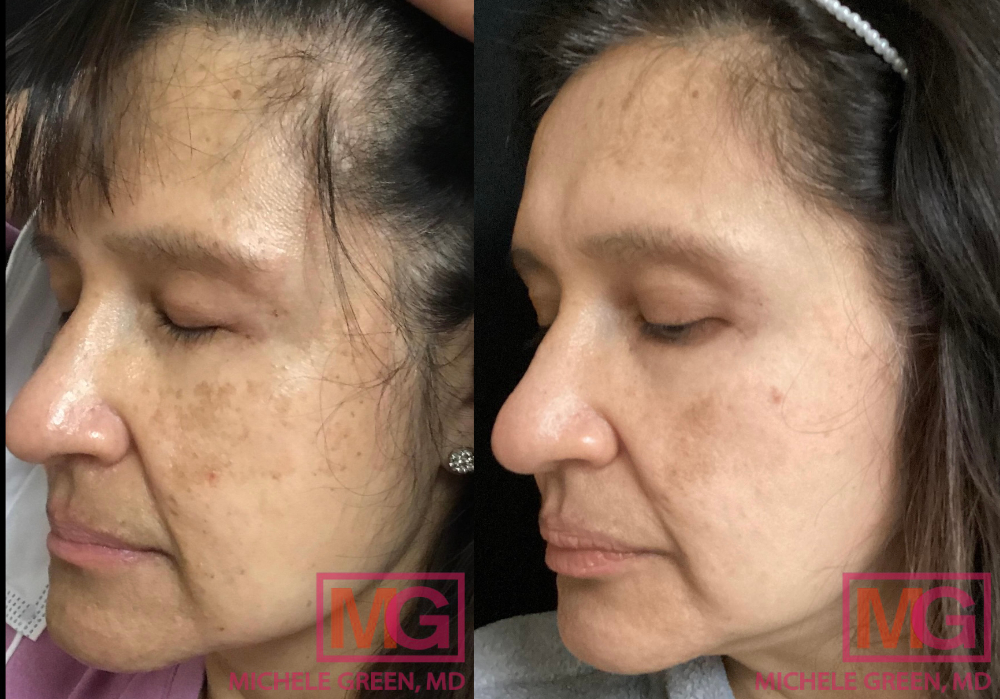
Cosmelan 6 months before and after
How can I get started with oral Tranexamic acid for melasma treatment today?
Dr. Michele Green is an expert in cosmetic dermatology and specializes in melasma, hyperpigmentation, and various other skin conditions. She has been safely and effectively treating all different types of hyperpigmentation and melasma for patents of all skin types for over 25 years in her discreet, private, Upper East Side, dermatology office. If you are struggling with melasma, post-inflammatory hyperpigmentation, sun spots, sun damage, or other forms of hyperpigmentation, Dr. Green is here to help. Please call our NYC office today at 212-535-3088 or contact us online to schedule a consultation for your melasma and see what is the best cosmetic treatment for you.
 212-535-3088
212-535-3088